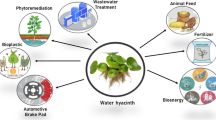Abstract
Studies on waste production and feeding management of Penaeusmonodon in semi-intensive culture system were carried out for foursuccessive crops at a commercial farm (M/S Suryo Udyog Ltd.) at Chandipur Coastof Orissa, India, at six different stocking densities. The prescribed feedingprogramme of C.P. Group, Thailand (NOVO-shrimp feed) were adopted andstandardized during first two crops and the standardized feeding scheme wasevaluated in the last two crops. Influence of standardized feeding programme onaverage feed conversion ratio (FCR) of P. monodon washighlysignificant (p < 0.001) against that of manufacturer's (NOVO-feed)prescribedfeeding programme. A feeding frequency of more than four times a day showed noimprovement in growth rate and there was no change in diurnal feeding habitprobably due to the fact that, in scientific farming, aquatic environment isartificially controlled. It was also observed that, as the age and weight ofshrimp increases, feed % decreases from 8.8 to 1.9% and lift net(LN)% increases from 2.4 to 4.3% for 1–40 gmeanbody weight of P. monodon respectively. The higher thestockingdensity, the higher was the FCR and sedimentation rate. In the presentexperiment,the sedimentation rate was estimated to be 49.5 m3 (dryvolume)/1000.0 kg of shrimp biomass. The average quantity of wastematter production was only 571.4 kg of organic matter, 10.21kg of nitrogen and 0.527 kg of phosphorus at anaverage FCR of 1.437 and stocking density of 22.5 pcs m-2 during the four crop experimental period.
Similar content being viewed by others
References
Abesamis G.C. 1989. Philippine Shrimp growout practice. In: Akiyama D.M. (ed.), Proceedings of the S-E Asia Shrimp Farm Management Workshop. American Soybean Association, Singapore, pp. 93-101.
Akiyama D.M. and Chwang N.L.M. 1989. Shrimp feed requirement and feed management. In: Akiyama D.M. (ed.), Proceedings of the S-E Asia Shrimp Farm Management Workshop. American Soybean Association, Singapore, pp. 75-82.
Akiyama D.M. and Chwang N.L.M. 1995. Shrimp feed requirements and feed management. In: Aqua International, India, August-September 1995, pp. 14-27.
Anonymous 1991. Asian Shrimp News. No. 7, 1991, Bangkok, Thailand.
Anonymous 1994. C.P. Shrimp News, 2(1). January 1994, Thailand.
APHA, American Public Health Association 1989. Standard Methods for Examination of Water and Waste Water 17th edn.
Banchong T. 1995. Environmental issues of shrimp farming-south east Asian experience, MPEDA. In: Indaqua-95 special publ.
Biswas K.P. 1993. Fisheries Manual. Bhagabat Press and Publishers, Cuttack, India, 436 pp.
Boyd C.E. 1995.Water quality management in shrimp farming. In: Fisheries World, India, October 1995, pp. 33-38.
Dall W. 1967. The functional anatomy of the digestive tract of a shrimp Metapenaeus benetae. Australian J. of Zoology 15: 699-714.
Dash M.C. and Pattanaik P.N. 1994. Brackish Water Prawn Culture. 1st edn. Palani Paramount Publications, Madras, India, 233 pp.
Lovett D.L. and Felder D.L. 1990. Ontogeny of kinematics in the gut of white shrimp Penaeus setiferus (Decapoda:Penaeidae). J. of Crustacian Biol. 10: 53-68.
Mc Tigue T.A. and Feller R.J. 1989. Feeding of juvenile white shrimp Penaeus setiferus: periodic or continuous? Marine ecology progress series. 52: 227-233.
Mohanty 1996. Effect of turbidity and its management in aquaculture. Fisheries World 3: 24-25.
Mohanty 1997. Studies on scientific management of semi-intensive culture of black tiger shrimp, Penaeus monodon at Balasore-Bhadrak coast of Orissa State (India). PhD Dissertation.
Mohanty 1999. Growth performance of Penaeus monodon at different stocking density. J. Inland Fish. Soc. India 31.
NACA 1994. The Environmental Management of Coastal Aquaculture: An assessment of shrimp culture in southern Thailand. Final report submitted to the office of the Environmental Policy and Planning. NACA, Bangkok, Thailand, 167 p.
Raymond H. and Lagardere J.P. 1988. Rythme alimentaire de Penaeus japonicus (Bate) on marais maritime. Compte Rendu Hebdomadaire des Seanses deL' Academic des Sciences de Paris 307: 407-413.
Robertson L., Lawrence A.L. and Castille F. 1992. Feeding Frequency and Feeding Time Effects on Growth of Penaeus Vannamei. WAS-92. In: Wijban J. (ed.), Proceedings of the Special session on shrimp farming. World Aquaculture Society, Baton Rouge, LA, USA.
Sedgewick R.W. 1979. Effect of ration size and feeding frequency on the growth and food conversion of juvenile Penaeus merguiensis, Deman. Aquaculture 16: 279-298.
Wyban J.A. and Sweeney J.N. 1989. Intensive shrimp grow-out trials in round ponds. Aquaculture 76: 215-225.
Author information
Authors and Affiliations
Rights and permissions
About this article
Cite this article
Mohanty, R.K. Feeding management and waste production in semi-intensive farming of penaeus monodon (fab.) at different stocking densities. Aquaculture International 9, 345–355 (2001). https://doi.org/10.1023/A:1020421309414
Issue Date:
DOI: https://doi.org/10.1023/A:1020421309414




